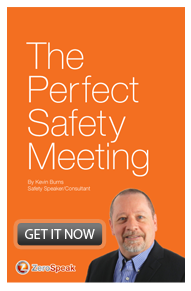5 Reasons Why Poor Safety Promotion Increases Incident Numbers
When marketing of safety goes up, safety-incident numbers go down.

Plain and simple, this works. Raise awareness of safety, sell the idea of safety and you will increase safety results. People choose safety when asked to.
Advanced warning campaigns for distracted driving, drunk driving and seat belts are all great examples. When marketing is high, when people are talking about how the police will be out on the highways, safety incidents go down.
Safety promotion forces people to consciously think about safety in the moment. A static billboard sign at the side of the highway asking you to buckle up has less of an effect than a warning on the radio that the highway you're driving on has a check-stop ahead.
When people are talking about safety in the moment, it gets your attention. Thinking that a few "safety now" signs in your workplace will get buy-in from your employees is foolish thinking. A few generic safety promotion signs are NOT a safety campaign. It will not get employees to buy-in to safety.
Hazard warning signs do not qualify as safety promotion. Hazard signage warns of a localized potential danger. Besides, warning of danger is not the same as promoting safety.
Safety promotion encourages people to make conscious decisions in favor of safety. Your workplace may have a superior set of rules, processes and procedures, but can not be classified as safety promotion. People who follow rules don't automatically buy-in to safety. Without the buy-in, no matter how good your processes and rules are, your incident numbers are going to rise.
Assuming you already have a good set of standards, processes and procedures in place, there are five reasons why an on-going absence of safety promotion will cause incident numbers to rise:
1Safety is not top-of-mind: which means that safety promotion has taken a backseat or that there has been an assumption that all employees are sick to death (interesting choice of words in safety) of being harped on in safety. It's only people who don't buy-in to safety that get annoyed by safety messages. That should be a clue you need to pick up the safety promotion. Or maybe you've abandoned your safety promotion because you got busy with other things.
2Production is encouraged ahead of safety: a statement that managers would vehemently deny they do. But ask workers what they are being pushed to do by their supervisors and they will answer "production over safety." Typically, you see this in short-timeframe, high-production environments: farm harvest, rushing to complete before ice-roads melt, freeze-up, drilling season or road construction season. Workers get pushed for more production in a short timeframe working extended hours creating fatigue issues which result in poor decisions being made. When the focus is on beating a deadline, it's off of safety.
3A change in the environment: people are creatures of habit and get into routines when it comes to work. The first snowfall of the year always creates havoc. Sudden shifts in weather or moving to an unfamiliar job-site location create safety issues. Anytime companies compress longer hours into fewer days, it upsets the routines of sleep and rest - creating fatigue-inspired decisions on the job. Add in an absence of safety promotion and you've got an environment not focused on safety.
4Lowering the bar in hiring: it happens when the base of quality workers dries up in high-activity economies. That means having to lower the bar of expectation/qualification for entry into the job market and not compensating for training and promoting safety to a lower quality of worker. Offering the same training as you would a high-quality employee almost certainly means a safety issue down the road.
5It is simply the wrong safety message: a generic message that neither appeals to nor is appropriate for its target market. A wrong message can also be a message that has no follow-through - if the message of safety is not demonstrably supported by management or whose front-line supervisors don't meticulously support the tenets of the message.
You must make safety promotion a cornerstone of your safety program if you want to improve safety performance.
If you have never asked your people to choose safety, they won't likely have done it voluntarily. Rules alone don't get people to want to choose safety. Rules only force them to do just enough to not get fired.
Safety promotion and safety marketing campaigns are key to successfully transitioning your workplace into a culture of safety. In addition to speaking at safety meetings, I am experienced in building solid marketing and promotion strategies. Call me to ask how to start building a strong safety culture through the use of safety promotion and marketing.
Not sure how to make a safety meeting part of your safety buy-in campaign? Get my free ebook, The Perfect Safety Meeting.



